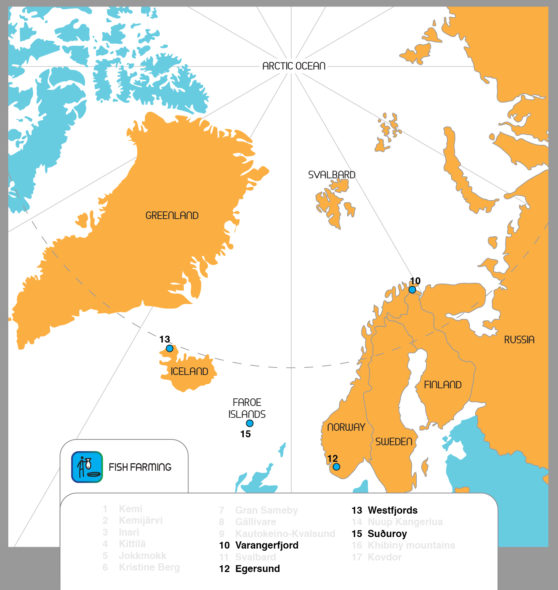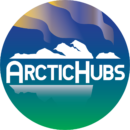![]()
Aquaculture is an economic sector that has developed over the past couple of decades on an industrial scale across numerous Arctic waters.
In no small part, recent rapid growth has occurred due to the increase in global demand in particular for Atlantic Salmon (salmo salar) which dominates aquaculture production in the region. Mirroring the domination in production of a single species,
the business of fish farming which initially spawned a number of small local operators, has now consolidated in to a setting where a few major, now multinational companies dominate the industry.
With a need for clean, secluded waters, fish farming companies often establish themselves in rural locations where the fjords are suitable for cultivation and legislation allows fish farming in open sea cages. Such a large scale approach, has begun to place considerable strains on the resilience of isolated rural communities. Often dependant on undiversified economies, that are vulnersable to externally driven changes, these communities have been struggling for some time to maintain the well-being and quality of life of its citizens. Declining populations and restricted opportunities for a balance of work opportunties, are the everyday backdrop to aquaculture in the Arctic.
How is ArcticHubs project entering this realm?
The ways in which the global aquaculture industry interacts with local communities is indeed a complicated challenge. The ArcticHubs research project aims to facilitate an understanding of the policies and practices inherent in the expanding Arctic aquaculture sector.
Notably, the project will make recommendations for more sustainable future developments. Through the input of local inhabitants into the decision-making about their micro-environment, a previously under-valued voice will be raised.
Growth into an industrial scale sector, has put aquaculture into opposition with a number of other land/coast/sea users. Prominent amongst these in our hubs, are the presence of salmon anglers, who believe that culturing of Norwegian salmon stock in floating marine pens could has a negative effect on the wild salmon in Icelandic rivers and that salmon angling tourism is threatened. In Norway, Sámi fishermen are worried about how much the Varangerfjord can withstand increased fish farming production and have called for more knowledge to emerge about the carrying capacity of the fjord.
Furthermore, a range of environmental concerns have surfaced. These include health or sanitation concerns around the interaction between farmed stock and wild fish. Outbreaks notably of salmon sea-lice (Lepeophtheirus salmonisn), have required the further input of expensive treatments that becomes more impactful on smaller operations.
It has been suggested that there is a lack of tools and experience to objectively evaluate the social and environmental impact of fish farming on the fisheries.
Once again, it raises questions around ownership, and the potential to find a viable blend of newly emerging mostly local micro-enterprise businesses, alongside far larger national or international companies. As with the situations in other ArcticHubs, solutions require a greater awareness and a nuanced understanding across scales, interest groups, and disciplinary methods.
Where are our hubs?
The four fish farming hubs identified by the ArcticHubs project for closer research and analysis, understandably mostly cling to coastal areas. Although, Egersund hub in the south of Norway does include input from some fresh-water lacustrine aquaculture sites. Each of the hubs will be examining how aquaculture can face the challenges of understanding complex environmental changes.

Iceland (Westfjords #13); Faroe Islands (Suðuroy #15); Norway (Varangerfjord #10, Egersund #12);
Core ArcticHubs questions
The key research questions being raised around the fish farming hubs will target a clearer understanding as to what issues underlie competition across land/sea uses, and how solutions can be formulated to encompass the diverse interests that are present.
ArcticHubs activities will be clustered around some of the following debates:
- How to create a sustainable environmental setting with the growth to an industrial scale of fish farming – placed in a context of over-reliance on single species (Atlantic Salmon), the cost and spread of disease and impacts of commercial activity on local habitats
- Closer assessment of farmed and wild fish interaction with use in particular of data from innovative tools such as acoustic telemetry
- Where pressures on employment exist, assessment is needed as to how the emerging job opportunities do not become too homogenised – with an eye on the challenge of finding gender balance
- Again close consideration is required to acknowledge how international or global companies recognise and accommodate local social, environmental as well as economic conditions.
For all these debates, our researchers will utilise and innovatively adapt to new settings the principal ArcticHubs tools – PPGIS, a social licence to operate (SLO) system, and future scenario building.
